After World War II, many European economies were in a sorry state. France was no exception, and the government considered various options to stimulate the economy. One of the most obvious choices was to get the population mobile and spending money. To this end, they supported the production of affordable cars in a similar vein to Volkswagen’s Beetle. One of these “people’s cars” was the Renault 4CV. It remained on sale from 1947 to 1961. Its designate successor was the Dauphine, although their production runs did overlap by several years. The owner of the cars in this listing is offering one example of each. Buyers could choose either a 1955 4CV or a 1960 Dauphine. You could have either one for $6,500 or take home the pair for $12,000. If these French classics have captured your imagination, you will find them located in Victorville, California, and listed for sale here on Craigslist.
The 4CV, sometimes referred to as the “baby” Renault, first appeared on the French market in 1947 and remained in production until 1961. During that time, an impressive 1,105,543 examples rolled off the production line. Our feature car is a 1955 model that wears an interesting shade of blue. It is essentially complete, but the owner candidly admits that it needs work. He indicates that it requires rust repairs, which is not uncommon in these little classics. The panels have accumulated a few minor bruises and marks, but all look repairable. Depending on its rust issues, sourcing replacement steel is not difficult or expensive. Its exterior trim is all intact, and the glass appears to be in good condition.
As with the exterior, this little Renault’s interior is complete but needs plenty of TLC. The upholstered surfaces look pretty tired, and a retrim is on the cards. This could prove a challenge because trim kits aren’t exactly thick on the ground in the United States. However, French companies produce these items, and many are willing to ship internationally. Alternatively, the existing trim could serve as an effective template for an upholsterer to create something close to the original color and material. The center is missing out of the wheel, but there appear to be no other missing parts. The 4CV represents motoring at its most basic, so buyers shouldn’t expect to find loads of luxury extras. Even a radio was not an option in 1955.
Initially introduced with a 760cc four-cylinder engine that produced 17hp, the 4CV received an upgrade to a 748cc engine that produced 28hp from the 1950 model year. The power found its way to the road via a three-speed manual transaxle. The 4CV was by no means a fast car, but its little engine offered extraordinary flexibility. Our feature car comes with good news in this department. Its engine bay presents nicely, and for a good reason. The owner indicates that both the engine and transaxle are new. For those considering a restoration, a major mechanical refurbishment is one task that can disappear from their list. That reduces the project’s overall cost significantly, which is welcome news.
The Narvick Blue Dauphine rolled off the line in 1960. As with its older sibling, this Dauphine is complete. The owner admits that the vehicle requires restoration work, but he has commenced the process. Unfortunately, the Dauphine had a reputation for rust, and this car was no exception. However, the owner has replaced the floors. That makes this little classic rust-free apart from some areas of surface corrosion. The panels are surprisingly straight for a vehicle of this age, and the exterior trim looks like it is all restorable. There is no evidence of problems with the glass, so a cosmetic refresh on this car should be a straightforward process.
The Dauphine’s interior is essentially an evolution of its predecessor. Therefore, the same rules apply when it comes to the question of a retrim. This little French classic will need one, but finding a trim kit could be challenging. Once again, the choices fall to either sourcing one from a French supplier or using the existing interior as a pattern for an upholsterer to weave their magic. While the best term to describe this classic’s interior would be austere, these can look pretty nice once restored.
The drivetrain in the Dauphine represents an evolution of that found in the 4CV. Its rear-mounted, water-cooled 4-cylinder engine has a capacity of 845cc, and produces 34hp that finds its way to the road via a three-speed manual transaxle. Buyers with some extra cash in their pocket could opt for a Gordini version. While this only brought an additional 3hp to the table, its ace was that it featured a four-speed transmission. This vastly improved vehicle flexibility and resulted in significant performance improvements. The owner says that he has commenced mechanical work on this classic but doesn’t indicate how extensive this has been. The engine bay presents nicely, which is an encouraging sign. He says that significant work has been completed on both cars but doesn’t provide specific details beyond those that I’ve listed. Included in the sale is an extensive collection of parts that should help the buyer on their way towards their restoration goal.
While Renault built both the 4CV and Dauphine in significant numbers, it is rare to find them on our roads today. Many succumbed to the ravages of time and rust, while some owners treated them as disposable items, moving on to something bigger and better as finance is allowed. To spot a pair together is a rare treat and offers a tantalizing possibility. There’s no doubt that either car would capture the public’s attention at a Cars & Coffee, but that leaves the buyer with a choice. Would they buy one or the other, or should they hedge their bets and have both in their workshop. Which option would you choose?
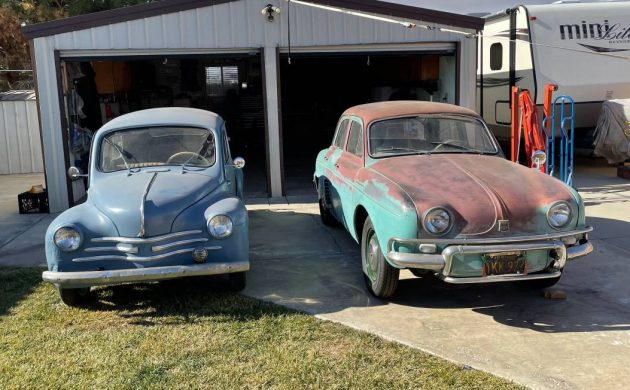
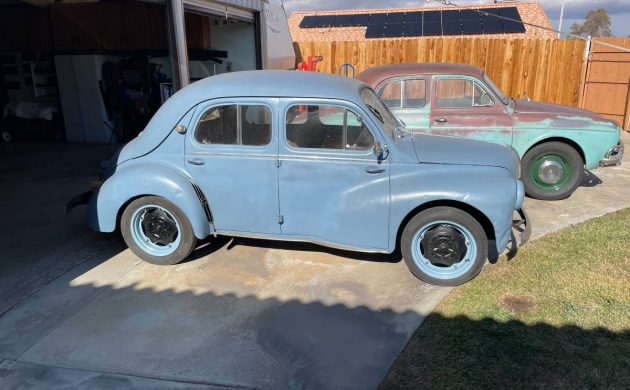
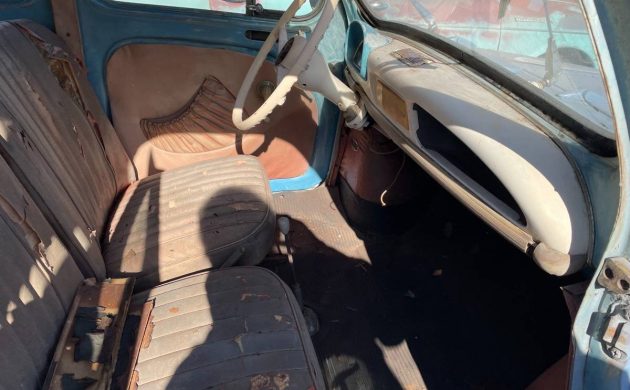
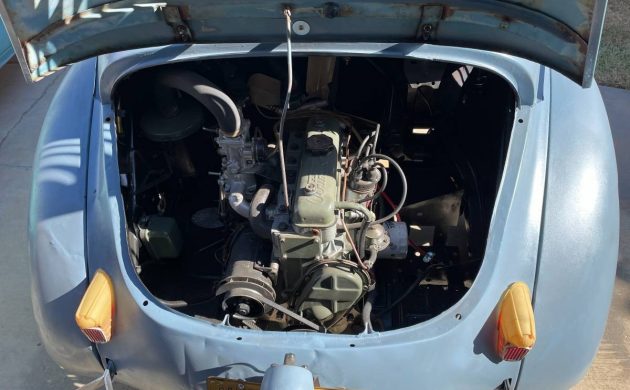


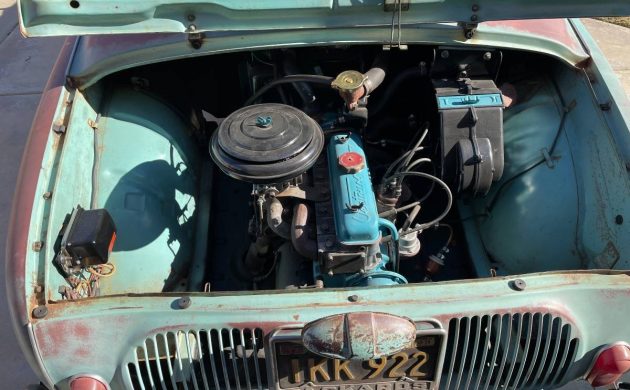
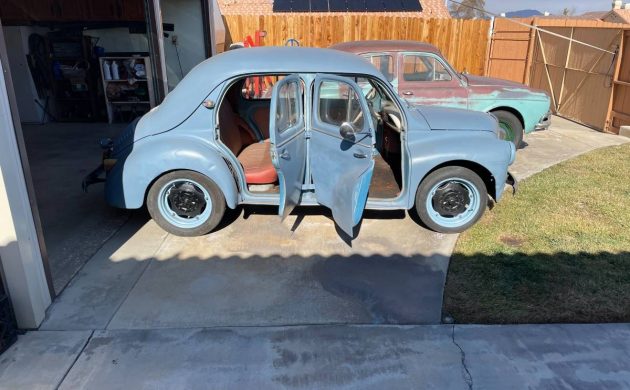


I had a Dauphine given to me – I immediately
gave it away.
You always remember your 1st,,,car, that is. The 4CV and I’ll defend these cars to the bitter end. A neighbor friend had a blue Dauphine like that, I wouldn’t say they were as common as the Bug, but a few. While not as common in the US, the 4CV was probably one of the most popular cars and was made in several countries. The Dauphine was more of a “real” car, you have to remember, in the late 50’s, there weren’t a lot of choices for a small car, and like it or not, small cars were becoming popular. The 4CV was actually a more modern car than the VW, 4 doors, more room, a real heater, kind of, I thought it was just a better car. The Dauphine was just a modern version, but still offered more than a VW, like a 2 tone horn and a gas gauge. Normally, due my connection with these, I’d say a great find, and it is, however, memory has a way of fading, and these are more of a novelty than actual transportation today. It is fun to see them again. I could think of a better way to spend $12g’s, however.
As a slight nit-pick, it was the VW that was the “Peoples Car”, and not the Renault. They were bitter enemies in the war, and I doubt the French would want that name attached to a 4CV, even though they looked similar.
Like yourself Howard, I have a warm spot in my heart for these, having learned how to drive in a R-10. Living in the Chicagoland area, I will admit I’ve never seen a 4CV, but had plenty of Dauphines running around the area. The R-10 was pretty much my mom’s car, and for 8 years, it served us well, that is until the tin worm had it’s way. I personally think the seller is grasping at straws on the price, especially when you consider parts are pretty much made out of unobtainium. vs the beetle, every bit as dependable, plus you could stay warm in the winter.
A lot of 4CVs were exported to Germany in the late 40s, early 50s!
They faired well in competition, their engine capacity being reduced in order to qualify for the under 750cc class.
One competed in all three Australian Redex “Round Australia Trials” (1953-55). Only one other car, a Standard Vanguard, did
Check the frames! My Dauphine had no body or floor rust, but the frame was rusted through.
No frame on these. Unibody construction. The panels are very thin and rust through easily. Usually, the floor goes first.
I remember both cars well but I was too young to drive back then. I was an avid collector of Corgi Toys and had just about all the cars they offered, most all being English or Euro.
Ralph Nader left these alone but they had the same fault as the early Corvairs- under the right circumstances (wrong inflation of the front vs. rear tires and heavy cross wind) the rear end would hike up and you would spin around on a level, clear, dry, road at 55 mph. Ended up face to face with a Corvair one day, and face to rear of a Dauphine about a month later. No touching either time, just a scare. (I drove my mother’s early Corvair, with proper tire inflation, and it never had an issue – it was a great car except for the gasoline heater under the “frunk” and the eventual rust.
A family friend that I grew up calling “Aunt” received a brand new 1960 Dauphine for her first car at 16. She recounted that the football players at her high school would pick the car up (one on each corner) and move it onto the sidewalk. One time they even turned it perpendicular in the spot! Harmless fun, impossible to do with today’s subcompacts nearing 3,000 pounds.
Never owned a French car before but from what I can see that Dauphine looks more like French roast.
Ahhh yes, wee wee cars, you piss on one and it disolves, a great french innovation, those genius them…
Don’t imagine the 4CV is anything like repairing a VW. The floor and frame were not intended to be separated. The floor was a complex set of shapes all welded together and integral with the rocker panels. I don’t know of replacement panels but when I owned mine ’81-’93 I replicated the “hat” sections with rectangular tubing welded to flat stock. the rectangular sections I bent over a starter housing using heat, I “sistered” the longerons with rectangular tubing and l/16″ angles. Lotta of welding and pop riveting. Anybody contemplating a restoration of a rusty 4CV that wants to do it really right should have a rotisary. These cars were not meant to be taken apart. I sold my 4CV to some men in Ohio, Wonder if it still exists.